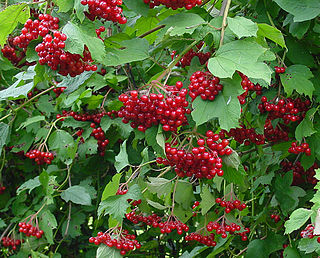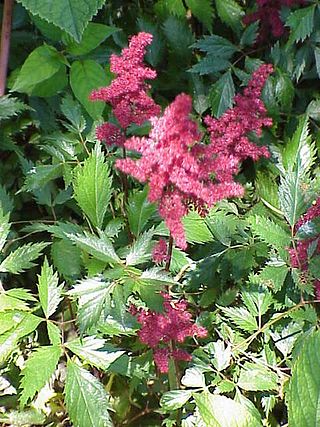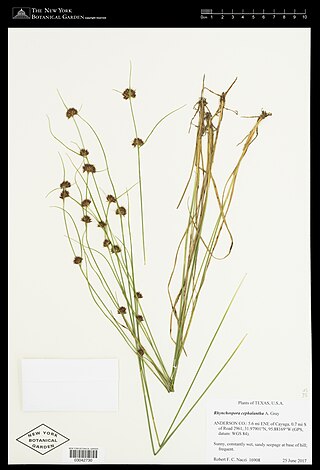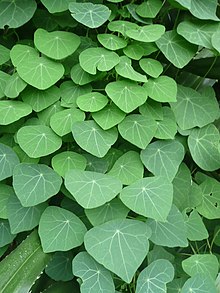
Viburnum is a genus of about 150–175 species of flowering plants in the moschatel family, Adoxaceae. Its current classification is based on molecular phylogeny. It was previously included in the honeysuckle family Caprifoliaceae.

Grass jelly, also known as leaf jelly or herb jelly, is a jelly-like dessert originating from China. It is commonly consumed in East Asia and Southeast Asia. It is created by using Chinese mesona and has a mild, slightly bitter taste. Grass jelly was invented by the Hakka people who historically used the food to alleviate heat stroke after long days working in the field. The dish was introduced to Southeast Asia by the Chinese diaspora. It is served chilled, with other toppings such as fruit, or in bubble tea or other drinks. Outside Asia, it is sold in Asian supermarkets.

Astilbe is a genus of 18 species of rhizomatous flowering plants within the family Saxifragaceae, native to mountain ravines and woodlands in Asia and North America. Some species are known by the common names false goat's beard and false spirea.

Juniperus squamata, the flaky juniper, or Himalayan juniper is a species of coniferous shrub in the cypress family Cupressaceae, native to the Himalayas and China.

Bunzō Hayata was a Japanese botanist noted for his taxonomic work in Japan and Formosa, present day Taiwan.

Ulmus uyematsuiHayata, commonly known as the Alishan elm, is endemic to forests at elevations of 800–2,500 metres (2,600–8,200 ft) in Alishan, Chiayi County, central Taiwan, where it is considered one of the minor tree species. The tree was first named and described by the Japanese botanist Bunzō Hayata in 1913, in the aftermath of the First Sino-Japanese War, when the Republic of Formosa was ceded to Japan.

Stephania is a genus of flowering plants in the family Menispermaceae, native to eastern and southern Asia and Australia. They are herbaceous perennial vines, growing to around four metres tall, with a large tuber. The leaves are arranged spirally on the stem and are peltate, with the leaf petiole attached near the centre of the leaf. The name Stephania comes from the Greek, "a crown". This refers to the anthers being arranged in a crown-like manner.

Mahonia oiwakensis is a species of plant in the barberry family, Berberidaceae. It is native to Taiwan, China and Myanmar, where it occurs at elevations of 600 to 3800 m. It has recently been found naturalized in South Africa.
Aralia castanopsicola, synonym Pentapanax castanopsicola, is a species of plant in the family Araliaceae. It is endemic to Taiwan. It is threatened by habitat loss. The specific epithet is spelt in various ways, including castanopsidicola.
Stephania tetrandra is a herbaceous perennial vine of the family Menispermaceae native to China and Taiwan. It grows from a short, woody caudex, climbing to a height of around three meters. The leaves are arranged spirally on the stem, and are peltate, i.e. with the leaf petiole attached near the centre of the leaf. Its root is used in traditional Chinese medicine (TCM).
Moliniopsis is a monotypic genus of flowering plants belonging to the family Poaceae. It just contains one species, Moliniopsis japonica(Hack.) Hayata.

Cunninghamia konishii is an endangered species of tree in the cypress family, Cupressaceae. It is native to southeast China (Fujian), Taiwan, Laos and Vietnam.

Cepharanthine is an antiinflammatory and antineoplastic compound isolated from Stephania. Due to these modalities, it has been shown effective against HTLV in lab research. Additionally, it has successfully been used to treat a diverse range of medical conditions, including radiation-induced leukopenia, idiopathic thrombocytopenic purpura, alopecia areata, alopecia pityrodes, venomous snakebites, xerostomia, sarcoidosis, refractory anemia and various cancer-related conditions. No safety issues have been observed with CEP, and side effects are very rarely reported.
Hypericum nagasawae is a species of the large genus Hypericum in the Hypericaceae family. It is native to Taiwan.

Hina Hayata is a Japanese international table tennis player. She is the most successful player on the ITTF Challenge Series since its inception in 2017. Owing to her stature, she is able to generate more spin on both sides than most female players. She is coached by Daisuka Ishida.
Stephania Haralabidis was born in Athens, Greece. Haralabidis is an American water polo player who played at USC and currently playing for Ethnikos and the U.S. national team. Haralabidis also has two sisters, her twin Ioanna and older sister Anastaia. Ioanna was also on the USC women's water polo team.

Newcastelia cephalantha is a species of plant belonging to the mint family, Lamiaceae, and native to several Australian states: Queensland, South Australia, Western Australia and the Northern Territory

Westringia cephalantha is a shrub in the Lamiaceae family that is endemic to Western Australia.
Stephania pierrei, also known as Stephania erecta or binh voi in Vietnamese, is a caudiciform vine native to the Indo-Chinese Peninsula. It is cultivated as a houseplant; in commerce it is typically described as Stephania erecta. It was first described by Ludwig Diels in 1910. The root or caudex is used medicinally in Vietnam; the 2006 Vietnam Red List of Medicinal Plants lists Stephania pierrei as a vulnerable species within the country.

Rhynchospora cephalantha, known by the common name of bunched beaksedge, is a member of the sedge family, Cyperaceae. It is a perennial herb, found throughout the eastern United States, from New York to Texas.














